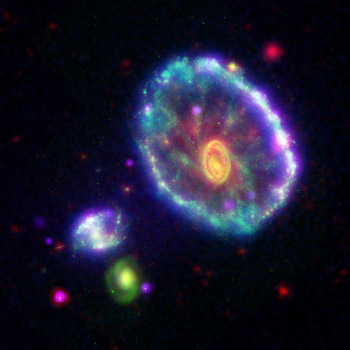As I sit here, Thursday afternoon at the American Astronomical Society meeting, things are winding down. Not too many folks wandering the exhibit halls, the talks are closing down, and we’ll start packing soon. I was far, far too busy to blog last night– we had a press dinner, and from there a passel of us went dancing in a happening DC bar (yes, not only do some astronomers dance, but some are pretty good at it– it was quite the spectacle last night).
There has been so much news I couldn’t keep up with it. So here’s a wrapup of some of the cooler things I saw:
NASA heads guy Mike Griffin gave a talk yesterday, which (duh) was very well attended. He took questions from the crowd (pre-selected by AAS President Craig Wheeler). Griffin restated his support for a Hubble servicing mission (which received warm applause), but the atmosphere changed when education came up. NASA has been extremely supportive of education in the past, but Griffin appears to have a different attitude. “We are not the Department of Education,” he said. There is quite a bit of scuttlebutt that education may get severely slashed in the new budget environment. Given that this pays my mortgage, it’s a matter of some concern to me. I’ll report more when I get more info.
The image at the top of this post is from the GALEX mission, which studies the ultraviolet light emitted by galaxies. UV traces things like where stars are forming and where they die. It has produced some great images, and this one is the famous Cartwheel Galaxy. The image is a combination of Chandra (X-ray, shown in purple), Hubble (visible, green), Spitzer (infrared, red), and GALEX’s own UV imagery (blue). For some reason, I like this image. It’s garish, but cool. The Cartwheel was probably once a normal galaxy like our Milky Way, but a smaller galaxy plunged through the middle of it, and the ripples from the gravity of collision warped the galaxy into that ring shape. The gas inside compressed and started forming stars, which booms out the UV.
This is a new Hubble image of the most famous gas cloud of them all: the great Orion Nebula. The full-res image is stunning (click the image for more), and they even have a zoomable image too. Very cool.
Astronomers have found the fastest-spinning star known. It’s a neutron star, the dead ultra-dense remnant of an exploded star. When a skater brings in her arms she spins faster, and the same thing happens to a star. When the core collapses, the spin increases hugely. Many neutron stars spin several times a second – think about that: something with twice the mass of the whole Sun, squeezed down into a ball a few miles across, and it’s spinning at tens of thousands of kilometers per hour. That’s cool! And this new spins a fantastic 716 times every second– faster than a blender’s blade.
There was lots more news, but I have some more meetings to go to before I head for home. This has been an incredible meeting, with a tremendous amount of new information, lots of good people, and enough astronomy to last anyone for quite some time.
… except me. I’ll have more astro-blog-o-rama to talk about later. There’s always more to talk about!’
